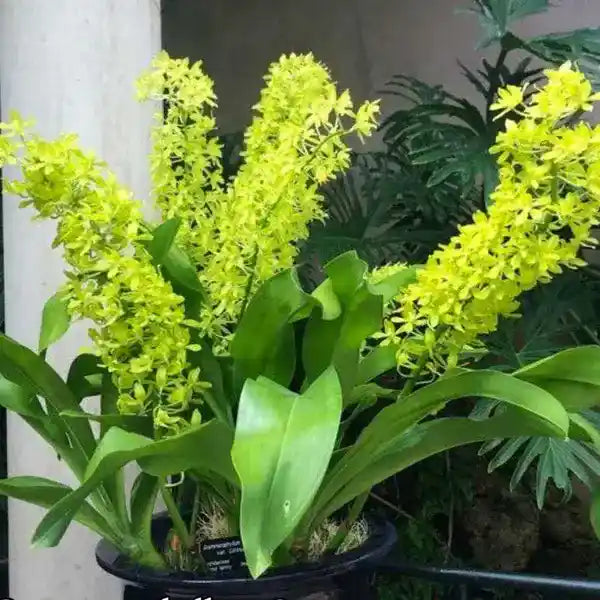
Grammatophyllum Green Blooming Stage
Selling Size : Last Image | Net Pot Included | Secure Packing
Grammatophyllum orchids, often called "Giant Orchids" or "Tiger Orchids," are renowned for their impressive size and spectacular blooms. While they can be imposing, their care is relatively straightforward if their specific needs are met.
Here's a comprehensive guide care to Grammatophyllum :
1. Light:
Bright, indirect light is essential. They need abundant light to flower well, similar to Cattleya or Dendrobium orchids.
Morning sun is ideal, especially in an east-facing window.
If using a south-facing window, provide light shading (e.g., a sheer curtain) from mid-February to late October to prevent leaf burn.
They can be grown outdoors in areas with filtered light, such as under a pine tree or shrub, during warmer months.
A light green leaf with a hint of yellow indicates optimal light, while dark green leaves suggest insufficient light.
2. Temperature:
Warm temperatures are crucial.
Daytime: 22−30∘C (72−85∘F).
Nighttime: A 6∘C (10∘F) drop is beneficial, aiming for 18−24∘C (65−75∘F). This temperature differential helps initiate flower buds and promotes stronger growth.
They can tolerate considerable summer heat as long as air circulation and humidity are increased.
While some acclimatized plants can handle brief periods down to $ -2^\circ C$ (28∘F), it's best to protect them from frost, especially when spiking or flowering.
3. Watering:
Water frequently and heavily during the growing season (typically March to October), especially when flower spikes are emerging.
The roots should be wet but allowed to dry quickly between waterings.
During winter months, they can be kept slightly drier, but watch for shriveled brown leaf tips, which indicate underwatering.
Pseudobulbs should be plump in summer and only slightly shriveled in winter; increase watering if they shrivel significantly.
Always water in the morning to allow leaves to dry before nightfall, preventing bacterial growth.
Use water low in alkalinity, such as rainwater, distilled water, or reverse osmosis water, if possible, to minimize mineral buildup. If using tap water, you may need to repot more frequently.
4. Humidity:
High humidity is beneficial, ideally between 45% and 60%.
This can be achieved with a humidifier or humidity tray. Ensure the plant is not standing in water to prevent root rot.
Good airflow is vital, especially in humid environments, to prevent fungal issues.
5. Potting Medium and Repotting:
Grammatophyllum needs a coarse, well-draining epiphyte mixture.
Recommended media include New Zealand Sphagnum Moss or a medium to large grade Traditional Orchid Bark Mix.
Large specimens are often best grown in wire or wooden baskets, as their strong, fast-growing root systems can break ordinary pots. Baskets also allow for excellent airflow.
Repotting is generally recommended every 2 years in the spring.
When repotting, carefully remove old media, trim off any dead roots or pseudobulbs, and position the oldest pseudobulbs towards the edge of the new pot. Fill with fresh medium, pressing firmly so the plant is stable.
Grammatophyllum have two distinct root types: thick normal roots that grow down, and thinner, hairy roots that grow upwards to catch debris (do not force these into the medium).
It's natural for them to discard old, leafless pseudobulbs, which may rot rapidly but typically don't spread rot to healthy parts of the plant. This is a natural process for them.
6. Fertilizing:
Fertilize consistently during the growing season.
A balanced fertilizer (e.g., 20-20-20 or 15-15-15 NPK) at half strength, applied every time you water, is often recommended for bark mixes, with a clear water flush once a month.
Some growers suggest fertilizing weekly during warmer months and once every other week in late fall through winter with a lighter feeding.
Grammatophyllum are sensitive to fertilizer salt buildup, so flushing regularly is important.
They are particularly fond of organic fertilizers like fish emulsion or manure teas.
To encourage blooming, a high-phosphorus fertilizer (e.g., 0-52-34 MPK) can be used for 3-4 consecutive weeks after a brief reduction in irrigation (a "dry period").
7. Re-blooming:
To encourage re-blooming, some growers recommend a short dry period (e.g., reduce irrigation for 1-2 days if you normally water daily).
Follow this with 3-4 weeks of a high-phosphorus fertilizer to stimulate flowering.
Once spikes appear, resume regular watering.
A mature plant with plenty of pseudobulbs is more likely to flower.
Important Considerations:
Grammatophyllum are very large orchids and require ample space.
Monitor your plant's leaves for signs of stress (e.g., yellowing from too much light, brown tips from underwatering).
Good air circulation is critical to prevent fungal issues, especially with high humidity.

